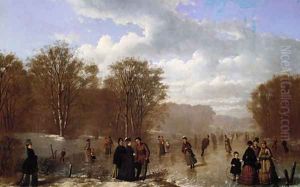Johan Mengels Culverhouse Paintings
Johan Mengels Culverhouse was a Dutch-born artist who spent a significant part of his life and career in England. Born in 1820 in the Netherlands, he migrated to England during the mid-19th century, a period when many European artists were moving around the continent and to the United Kingdom in search of new opportunities and audiences.
Culverhouse is primarily known for his detailed and atmospheric landscapes and genre scenes. His work is characterized by a precise attention to detail and a keen interest in capturing the changing effects of light and weather on the natural environment. This focus on light and atmosphere links him to the broader European art movements of the time, particularly to certain aspects of Romanticism and later to the Realist movement, though he maintained a distinctive style that is often recognized for its meticulous approach and clarity.
While not as widely known as some of his contemporaries, Culverhouse enjoyed a degree of success during his lifetime. His paintings were exhibited in various art venues including the Royal Academy in London, where he gained recognition amongst critics and the art-loving public. He was part of the burgeoning art scene in Victorian England, which was a period of great expansion and appreciation for the arts.
Culverhouse's works are now housed in various art collections and have been featured in historical art exhibitions that explore the 19th-century landscapes and genre paintings. Despite his death in 1894, his legacy continues through his contributions to the period's artistic developments and the charming quality of his paintings that continue to be appreciated by art historians and collectors alike.
